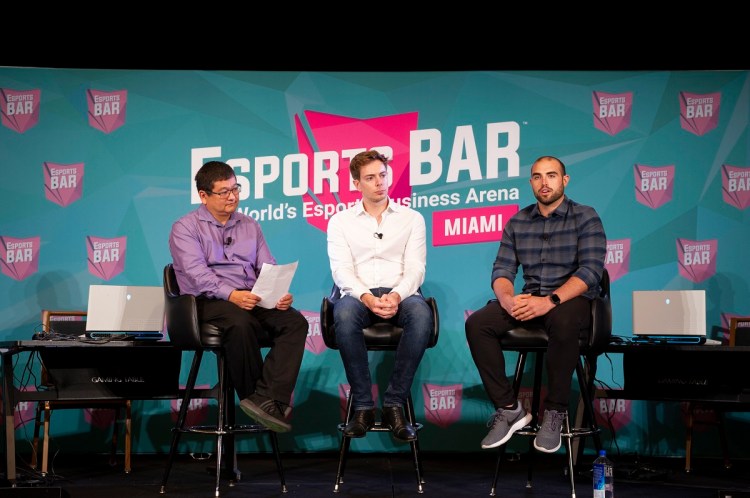Joe Barnes didn’t have enough data to know if esports and Bud Light were a good mix. Market watches like Nielsen are paying attention to esports, but they don’t have nearly as much data as they do for mainstream media such as television.
But Barnes, the head of experiential marketing at Bud Light, dove in anyway. He brainstormed with advisers like Stuart Saw, a senior vice president at the marketing agency Endeavor, and they came up with activations for games such as Overwatch. In one such activation, fans had to push a “payload” of beer a certain distance, just as players have to shoot their opponents and move a payload across a map during esports matches for the Overwatch League.
The result is that Anheuser-Busch has 70% share of the social sharing in beer for esports. There wasn’t enough data, but it was enough for Barnes to act and get his brand in front of the elusive millennial audience that doesn’t watch traditional media.
Here’s an edited transcript of our interview.
June 5th: The AI Audit in NYC
Join us next week in NYC to engage with top executive leaders, delving into strategies for auditing AI models to ensure fairness, optimal performance, and ethical compliance across diverse organizations. Secure your attendance for this exclusive invite-only event.
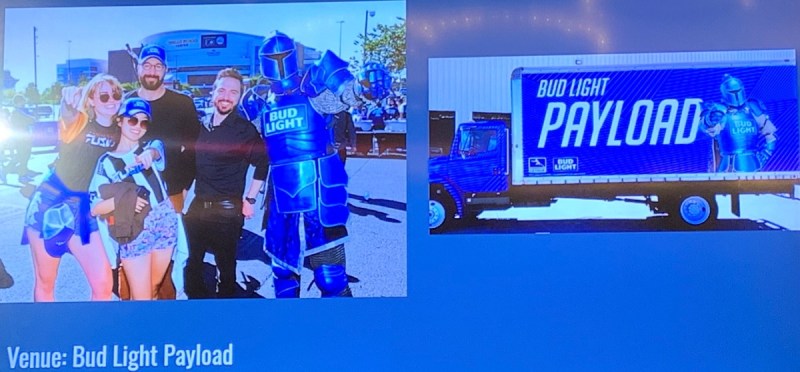
Above: Bud Light’s payload at Overwatch League event.
Stuart Saw: I head up esports at Endeavor. At Endeavor we work across the field. We work with brands like AB InBev as their strategy advisors, but then also we work in production. We work in merchandising and licensing and general consulting across the space. We work across the broad spectrum of esports.
Joe Barnes: I’m with Anheuser-Busch. I’m the head of sports marketing for the Bud Light brand. That oversees esports, but in addition to that it oversees the NFL, NHL, and NCAA.
GamesBeat: We saw some good examples of Bud Lite activation. How do you describe how you work together to pull these things together?
Barnes: Endeavor is our strategy agency for esports, and also for the NFL and hockey and others. This past weekend is a great example of how we use our brands to activate within esports. Especially with a non-endemic brand, it’s a huge challenge to break through. We’re not going to make you faster or give you better posture when you’re playing, but we are beer, and we can do a lot of fun things.
The insight that we used for this payload activation is, how can we bring the video game to life for this community? It’s a virtual community that we want to bring together in real life to do things — for us, most important, to drink beers together. We threw out there to the community that we won’t serve beer for the fan fest at the Overwatch League grand finals unless they all come out and escort the payload together.
We needed 100 to come out. We had about 300. We also had some influencers from the league. We had Zedd. We had former Eagles player Brian Westbrook. They all showed up to move this payload, which was really exciting for the fans. Then they also got to drink plenty of Bud Lights at the fan fest before going to enjoy the grand finals.
GamesBeat: Stuart, were you helping to develop this?
Saw: Certainly. In Endeavor’s role, we have a sporting team that will ideate with Joe and then work to unlock opportunities for them. We’ll do this across space, both on a digital level and then on a physical level at events.

Above: Bud Light isn’t messing around when it comes to esports marketing.
GamesBeat: Joe, you mentioned you had a 70 percent share of social voice. Can you talk about that?
Barnes: It’s super important to us as a brand in the esports space that our consumers talk about us. It’s a digital community. It’s much bigger than just the traditional logo slot that we would have with the NFL or MLB stadiums. We need to break through. We need to be with these fans in their own space.
A good metric we look at is social conversations. Throughout the year — and again, we had a nice shout-out before — we had the Bud Light happy hour that we do weekly. We’re putting out content on social to get people to tune in, and fans in turn are talking about that. From our data, what we pulled back is that within the beer space, we’re above 70 percent, which is extremely dominant. We’re happy with the results, and the community is paying us back by talking about us and engaging with our brand, which is the dream scenario for a marketer.
GamesBeat: We did a Q&A earlier where you talked about how you would like more data in this space, but you also had enough data to act. You moved fast, and that’s how you got to that 70 percent share over the other beer makers.
Barnes: Data is evolving in the space. We’re a data-based company. We like to use data to form insights, and then we can act on that. We’re working with Stuart and Endeavor. I’ll let him touch a bit more on how we can get better data, more refined, and act on that in a better way.
Saw: One of the challenges is data back. For a lot of the activations, the Twitch dashboard we all rely on is pretty limited in what it can provide. We have a group within Endeavor called Endeavor Analytics, and what they pulled and were working through here–they went through various sources that showed the challenges of really sizing the market.
In doing this, we’re going to start with looking at the ranges and all of the groups that play in them. Then we’ll compare that to traditional sports to show you how much easier that is in traditional sports, because that’s a much more mature data market. Here you can see the fan counts within esports. You have a range of fan counts, from [name – 5:40] Index saying 30 million people in the U.S. audience, versus 90 million on the other end with Nielsen. You have a variety of groups that sit in the middle of what is a giant range as we try to sum up how big esports really is in the U.S. That’s a real challenge for brands.
In sports you can see that each of these agencies that create this data, they have their own metrics and their own way of doing it, but you can see that in the three sports on the bottom, is pentagon is pretty evenly spread out. They’re consistent in how they level out. In esports that variance tells you that there’s still a lot of development that needs to go on. There’s not a lot of data being shared back with these research groups. They play an important role for brands as they evaluate the space.
This is how heavily the female audience weights in the space. Again, massive variance across these. The audience age piece, as MonteCristo touched on for Bud Light, very important to make sure that we’re hitting an over-21 audience. Again, you can see a massive spectrum as far as how much of the audience is under 30. That varies from as much as 90 percent on the Nielsen esports report to as low as 30 percent on MRI-Simmons.

Above: Left to right: Dean Takahashi of GamesBeat, Stuart Saw of Endeavor, and Joe Barnes of Anheuser-Busch.
This is a real challenge. This is something all brands face as they look at the space. Brands are coming in with a certain level of experience that they get from advertising in sports and other spaces. They come to esports and ask, “What can we do?” We turn around and say, “Well, this is what we think it looks like? Here’s a Twitch dashboard.” It doesn’t really cut it.
It’s very important that we as an industry continue to level up and continue to press all of those we market with to press back. The Overwatch League has done a good job with trying to level up the data they get back from Twitch, but that’s a platform we need help from as far as getting more data.
GamesBeat: In some ways that’s a bit of a mess, but Joe, do you see something actionable here, where there’s enough information for you?
Barnes: On that particular slide, no. For this one, the metric we never would look at is under the age of 30. For us, it’s what about 21 and over? That presents its own challenges. The most popular game in the country and the world skews about 70 percent under 21. There are a lot of challenges that come with the space. Having the rate data helps us be able to get these deals done through our legal teams, and then we can act on that.
GamesBeat: The Twitch channel came up earlier. That’s one way you can do that.
Barnes: That’s a lever we’re able to play with, sure, our Bud Light Twitch channel, which is a huge asset for us. We can age gate that, so that only 21+ can enter, which helps us from a regulatory standpoint. Also, making sure the messaging is appropriate for the audience watching.
Saw: What I’d say to add on to the success of the Bud Light Beer League and the Bud Light Twitch channel, the audience numbers they’re pulling in on recurring weekly shows are growing on a week-on-week basis to numbers that you just don’t see for branded content. The Bud team has proved out that if you come with content that is additive, people will go to it. This is a content-hungry audience. The average esports consumer is consuming more than 100 minutes of content per day. If you can add to that experience, add something they’re not getting elsewhere, they will come to you, and as a brand you can be very successful.
Barnes: That’s 100 percent it. As a brand marketer, what better tool could you have than people coming and wanting to consume your content? We pay hundreds of millions of dollars a year to put our content in front of them where they don’t want to see it. Instead of being a brand interrupter, we can bring value back to the fans.
To Stuart’s point, we’re peaking at 5,000 concurrents with some of our content that’s coming on a weekly basis. That number continues to increase because fans like what we’re doing. They like the value we provide back to them. We value them as consumers, as fans of esports.
GamesBeat: When different parties come and question you, do they ask about the hype around esports? Do you have a particular piece of data that you respond with? “Yes, there’s hype, but look at what’s really happening with audiences here that should tell you there’s something here that we should care about?”
Saw: First of all, we’ll use the engagement figures. We’ll take that data and then we’ll take the engagement figures — how many people are available to these advertisers on TV? How much time are they spending on Twitch, on YouTube, on the platforms? These pieces are just saying, “Look, it’s not just hype.” Yes, we’ve all gotten over the idea of, “People want to watch video games? That’s crazy! These people are going to a stadium? That’s crazy!” We’ve all moved past that to, “What’s the actual engagement?” and as we just talked about with Joe, how you can capture that engagement as a brand.
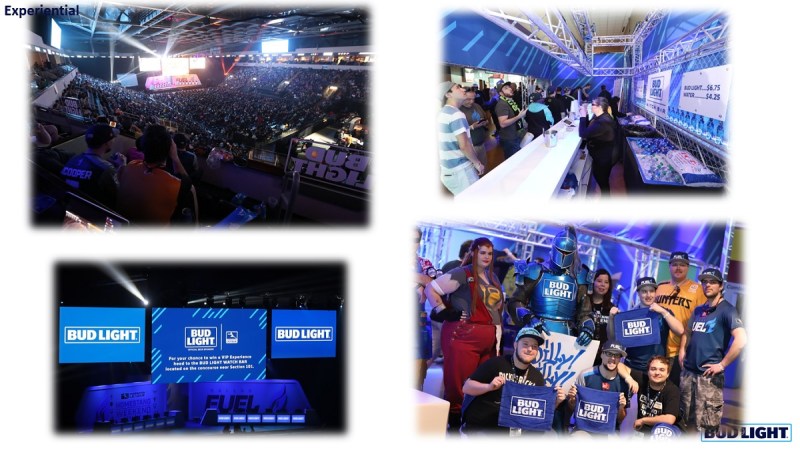
Above: Anheuser-Busch doesn’t want esports fans to become wine drinkers.
GamesBeat: There was one data point I saw recently from EsportsEarnings.com, talking about how they expect the prize pool from this year to reach something like $300 million. Just the year before it was $160 million. Those are good metrics. Joe, if you have an ask for what you want to get access to as far as data, so that you can take action in the future, what are some things that you’d like to see more of?
Barnes: Every conversation that I have with partners, current or prospective, starts with, “What is the content you’re going to give me so that I can put it on my Twitch channel?” This year we’re programming between two and four nights and week. Next year we’re going to be at seven nights a week. We don’t want traditional sponsorship assets. If you’re going to sell me on being the presenting partner of something, that could be great if you have an awareness problem, but Bud Light has 99 percent awareness.
I don’t need to slap my label anywhere. I need my community to grow. Come to me with content that your fans, who you know way better than I do–come to me with ideas that will add value back to them. We can put it on the Bud Light Twitch channel and give them something really great. That’s how we can continue to grow.
GamesBeat: How do you arrive at the right games you want to have a presence with, and the right streamers as well?
Barnes: I have a really great strategist next to me that helps. But for us it’s a mix. There’s not, within this space, a silver bullet that can solve all of our problems. You have to have diverse assets. Everything we talk about is esports generally, and those numbers are huge, but if you double-click and go title by title, those numbers aren’t as big.
We need to be in multiple spaces. We need to have different titles and types of games. We have a great partnership with Tekken, but it can’t all be fighting games. It has to be NBA2K in the mix. It has to be a bunch of different assets, because then we can tap into different fanbases, which is what makes those esports numbers so large for us.
Saw: The way we work as Endeavor, as a global marketing agency–we work with Bud Light. We work with T-Mobile as well in esports. Then we have other brands we work with, Visa or Marriott, outside of esports. They come to us and say, “How can we get into esports? What games can we go to?”
The evolution of that conversation goes, “Well, I don’t want a red blood game.” They don’t like shooting or violence. “Oh, I also want a sports game.” But EA won’t let us do this and that in their league. “I want to activate in this country.” Ah, but the game we’ve narrowed down on isn’t very big in that country. This path we have to go down is very important, because that’s the number one challenge. I quite literally have some brands who want to spend in esports, and we’ve gone through this step by step guide, and in the end they have nowhere to place their money.
That’s important. Red blood is the biggest factor, and then country by country relevance is a huge factor. Open ecosystems are another one. The Valve open ecosystem is very important, because that allows a lot of people to pop up tournaments and create things for brands to get involved.
The usual place that trickle goes down to, if you’re unable to get in on something great like the Overwatch League, is they’ll end up working with streamers, and a variety of streamers. If you think of streamers who dabble in a little Fortnite, a little first-person shooter, but then also do a lot of sports games, a lot of realtime strategy games, they can be a jack of all trades. These influencers are where a lot of brand money is trickling down to.
I would say that in two years, the amount of money that’s gone into esports and then landed straight at this, what was probably originally lower on the totem pole of esports sponsorship opportunities, it’s really gone down there very quickly. The streamers are doing very well out of it.
GamesBeat: Joe mentioned that Bud Light’s Twitch channel, which has an age gate — how good a solution is having your own custom Twitch channel for other kinds of brands out there that are running into these kinds of problems?
Saw: The work that Anheuser-Busch has done has pioneered leading your own channel. There’s no greater praise than praise from MonteCristo. He’s a hard man to please. That, I think, is fantastic. You heard Joe mention that this year they have this many nights of programming, and next year there will be even more. They want that to continue growing. It shows there is viability in that strategy. Other brands that want to get involved there, though, are going to have to play catch-up in terms of, where are the opportunities they can add value?
GamesBeat: Joe, where are you going in the future?
Barnes: We’re going to continue to invest in a bigger way next year. We’re going to continue to expand the Twitch channel. We want to be live every night. We want to be a destination that fans know. At 7:00, we’ll have the Bud Light happy hour. At 7:00 we’re going to crack open beers, because that’s the new habit, the new occasion Bud Light is starting to create in the consumer mind.
We’ll look to more activations. The payload is a great idea, going beyond the logo slap to actually activating the event and giving value back to the fans. As we look to the expanding home matches and the big sellouts, we need to be part of it. But we need to be part of it in a new and innovative way that the fans take notice of.
Saw: From Endeavor’s perspective, on a marketing level, we’re looking to help the access piece. Get to that point where, when a brand comes to us and says, “We need a new idea for esports,” we’ve not got this blockage we regularly have in the pipelines. “We have these opportunities for you. This is how we can navigate some of the problems. This is how we can show you ROI.”
Not only for Endeavor, but for me personally as an esports fan, this is a problem that’s a personal passion point to solve. We need, as an industry, to balance our books. We need to welcome brands and create opportunities for brands. That’s something we’re striving as a team to be continually evolving. What are the ways that brands get in the space? How do they justify their involvement in the space. How can we get ROI?
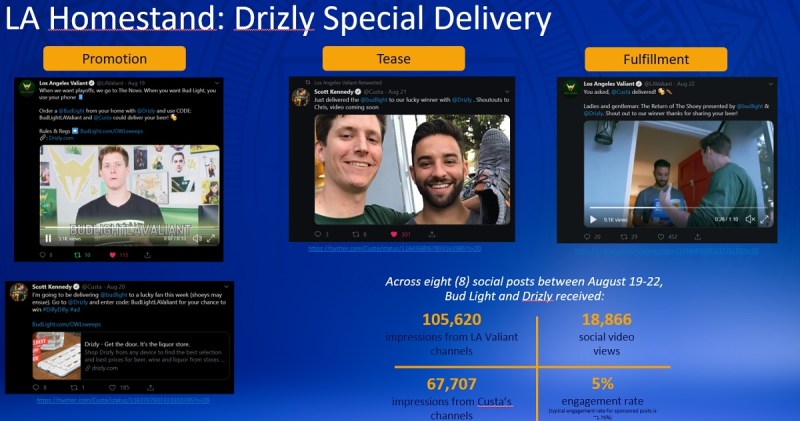
Above: Anheuser-Busch is experimenting with esports marketing.
GamesBeat: Have you run into anything that you’d call, among the smaller games, something like the golf of esports? Something with a very desirable demographic, if not the biggest audience in the world? Does such a thing exist?
Barnes: It probably does. I haven’t seen it yet. For us we’re trying to hit the sweet spot. The target audience is 21 to 27. This sport is the youngest possible. We just have to make sure it skews above 21. For that, it’s perfect for us. I would almost take a step back and–the golf for Bud Light would be esports, rather than looking within the esports industry.
Question: Something that’s caused a lot of constriction is demographics, the ages within esports, as far as making game video content at scale. Are you doing anything from an analysis perspective, since you have your own channel — are you doing those deep dives to know, “Hey, I know that 30 percent of my audience is tuning into Fortnite content”? Are those shows providing a way to dig into those demographics and identify games, identify influencers that make for successful game video content?
Saw: First, I’ll whine at Justin Dellario to ask for more of those opportunities. Second, you raise a good point in terms of activating across a genre rather than a single channel. That’s a big factor. When you look at–”Hey, I’m advertising against League X.” Well, that means you’re getting the League X audience, not the esports audience. You’re not getting the streamers or the amateurs. You’re getting the pro piece.
Something we tell brands is that even with the limiting factor we have on the data that’s available — and Anheuser-Busch is perfect at this, if you look at activations around Overwatch all the way to Tekken — you need to be activating across esports and finding a way to get the entire audience. Think of esports as one giant Venn diagram of audiences that overlap in different places. That’s how you have to attack it from a strategy perspective.
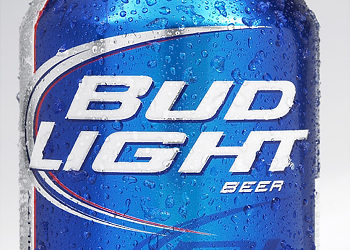
Above: Bud Light is pushing into esports as well.
Question: From a measurement perspective, for Bud Light, you guys I’m sure have a television budget, a digital budget. Is there’s a metric under one of those two that would make you more willing to spend in this space?
Barnes: What we’re looking at as a brand, if you take a step back — if we look at the TV metrics, the numbers there, it’s great that if I air during Sunday night football, I’m going to reach 30 percent of America. But do those people pay attention? Do they want to see my content? Or was I just interrupting, and they actually have a bad taste in their mouth around Bud Light?
When we look at these engagements, the number one priority–if people are actively engaging with the brand, we’re going to throw more money at that to keep this cumulative effect going, because whatever we’re doing is working.
Question: How do you track, whether it’s a logo slap or an engagement or these activations — how do you go down the path where you convert it into interest from the audience?
Barnes: We look at varied factors. We do have agencies like Stuart and others that can do assessments for us. We know the value of signage in an NFL stadium. We know the value of putting your logo by an NFL shield. We have all that data. When we’re making these decisions, we need to look at what the fans are engaging with, to this last point. That’s the investment decision. If fans are engaging and it’s growing and it’s working, that’s where our money is going to go.
Disclosure: The organizers of Esports Bar Miami paid my way to Miami. Our coverage remains objective.
